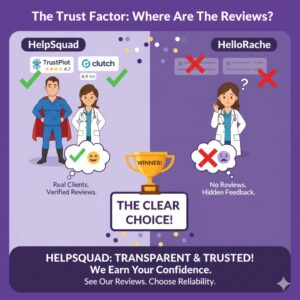How to Generate Leads Without Making Customers Feel Like Pieces of Meat
26 Jun 2020 By: Shelby Shaffer
Updated
“Fish are friends, not food!”
I’m sure you remember this iconic quote from Finding Nemo when Bruce, Anchor, and Chum invited Marlin and Dory to their Fish-Friendly Sharks support group.
As a business owner, YOU are the shark, and your customers are the fish. This same friendly principle should be applied to your business model, specifically when generating leads for your business. Customers are your friends, NOT your prey.
Shouting at potential customers to buy from you has NEVER been consistently effective. Traditional marketing methods like, cold calling, are outdated and impersonal. In fact, 60% of cold calls go unanswered and 84% of buyers complain that sales reps on cold calls are annoying! (smallbizgenius)
Customers want to feel valued by the businesses they choose to work with. They’re spending their hard-earned money, so they want to know those businesses appreciate them. A customer wants to feel like more than a price tag. They want to be educated and empowered to make an informed buying decision.
What would your customers say about your lead generation process? Do you think they feel informed and guided? Or do you think they feel attacked and pushed into a sale? Are you a Bruce, or are you Jaws?
First, What is a Lead?
Great question! Lead generation starts with understanding what a “lead” is. HubSpot says it best; a lead is any person who indicates interest in a company’s product or service. Leads are typically identified after the potential customer has started the buyer’s journey, and is still identifying his or her problem. Potential customers are searching on Google for answers and clicking the links that might offer the best solution.
Pretend you’re a customer. You’re experiencing a problem; you want to lose weight. (I think a lot of people can relate to this thanks to COVID’s quarantine.) You find that your current lifestyle is not exactly ideal, so you turn to Google to conduct some research. Your Google searches might include
- How to Lose Weight at Home
- How to Start a Diet
- What Diet Should I Follow
You find thousands of articles talking about those topics and more. You click on an article called “6 Week Weight Loss – How to Lead a Healthier Lifestyle From Home”. The article takes you to a website for a HIIT gym that offers a wide variety of online fitness classes as well as access to dietitians and nutritionists. You fill out a survey on their site, “How and Where Do I Start”.
Congratulations, you are now a lead!
Different Types of Leads
There are a few different types of leads businesses should understand. The most important two are Marketing Qualified Leads and Sales Qualified Leads.
Marketing Qualified Lead (MQL)
Marketing Qualified Leads are people who have engaged with your marketing team’s content. This could be reading a blog, filling out a survey, or clicking on an ad. MQLs are still in the awareness stage of the buyer’s journey. They aren’t quite ready for a sales call yet.
Sales Qualified Lead (SQL)
A Sales Qualified Lead is someone who had taken an action that expressly indicates his or her interest in becoming a customer. This could be someone who filled out a contact form, subscribed to your newsletter, or downloaded an offer.
What is Lead Generation?
Lead generation is the process of attracting strangers and converting them into customers. Generating leads is how your marketing team is attracting the right visitors so your sales team can turn them into paying customers. In short, generating leads is how your business survives!
Lead generations should be about educating, empowering, and entertaining your visitors. They should see you as a trusted and knowledgeable resource. The more they trust you, the more likely they are to buy from you. But if you fall short of educating them, and you are too “salesy”, they’re going to feel threatened. According to Marketing Charts, 8 in 10 US consumers (82%) and three-quarters (75%) of global respondents say they will continue to buy a brand they trust, even if another brand suddenly becomes hot and trendy.

Generating leads falls in the second stage of the buyer journey when website visitors are still considering their options and solutions for their problem. They’ve found your content with the use of strong keywords in blogs or social media content, and they are being funneled to fill out forms and taking actions on your website.
The more people you attract to your website, the more potential leads you have at your fingertips. But how do you turn website visitors into customers?
Generate Lead With Inbound Marketing
Ok, remember up there ^^ where we said you should be treating your customers like friends, not like your prey? It starts with your content.
The content your company is posting on your website and social media platforms should either be educational, empowering, or entertaining. Readers need to find value in the content you are sharing or they’ll have no reason to trust you or become your customer. Before we dive into generating leads that works, we need a crash course in Inbound Marketing.
HubSpot lives and dies by the Inbound Methodology, and we do too! Inbound marketing is attracting your customers, engaging them with your valuable content, and delighting them with success. It’s about putting the power in your visitors’ hands, giving them all the tools and resources they need to find their own answers. It’s non-invasive and it works. In fact, according to Weidert Group,
- Inbound marketing generates 3x more leads per dollar than traditional methods
- Persona driven content generated by inbound marketing increases SQLs by 45%
- Businesses that nurture leads make 50% more sales than businesses without a lead generation strategy.
Inbound marketing and lead generation are an iconic duo. Inbound marketing is your quarterback, while lead generation is your wide receiver. Your inbound marketing strategy will fuel your lead generation.
The inbound methodology is about attracting, engaging, and delighting visitors, turning them into customers, and repeating the process so they’re customers for life. Effective content that educates, empowers, or entertains will attract more visitors (or leads) to your website.
How Content Can Generate Leads
The golden question! How do you generate leads that convert into customers?
HubSpot (once again) has the answer. Inbound lead generation comes down to attracting, engaging, and delighting. Together, these tactics move strangers from the world wide web to your website, eventually turning them into your customers.
Attract
The first step in lead generation is attracting or pulling in website visitors. You want to set the tone early on that you are a trusted and valuable resource. At this stage, you shouldn’t have any ulterior motives besides building trust and educating your visitors.
Content in this stage should be centered around blogs, videos, social media, and ads that utilize specific keywords that will lead strangers to your website. The content should educate customers about their problems, and lead them to internal links on your site that are related and will offer more valuable information.
Engage
Once they’re on your website, you want to keep them there as long as possible. Offer them insights and solutions that align with their pain points and goals. You should be leading them through your site with CTAs to fill out forms, sign up for mailing lists, or download an even more informative and valuable offer.
Entering these warm leads into lead management campaigns, marketing automation workflows, or email campaigns are great ways to softly nurture these warm leads into customers.
Delight
The final stage to generating leads is delighting visitors with support and empowering them to find success with your product or service. This can consist of additional email marketing, reporting, or entering them into “next level’ marketing automation.
Just because they make a purchase, doesn’t mean the lead generation process ends here. You should continuously nurture leads after purchases are made. This shows that your company is invested in customers’ success and the customer feels valued instead of forgotten. Incorporating live chat customer support or surveys to assist, support, and request feedback from customers is a great way to delight these people.
Developing an effective strategy to generate leads won’t happen overnight. It will take some trial and error before you find a strategy that works for your unique business. But if one thing remains consistent throughout all lead generation strategies, it’s this: customers respond better when they’re treated like friends, not food!


